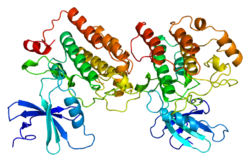| CSNK1E |
|---|
 |
| Available structures |
|---|
| PDB | Ortholog search: PDBe RCSB |
|---|
| List of PDB id codes |
|---|
4HNI, 4HOK |
|
|
| Identifiers |
|---|
| Aliases | CSNK1E, CKIepsilon, HCKIE, Casein kinase 1 isoform epsilon, casein kinase 1 epsilon, CKIe |
|---|
| External IDs | OMIM: 600863; MGI: 1351660; HomoloGene: 121695; GeneCards: CSNK1E; OMA:CSNK1E - orthologs |
|---|
| Gene location (Human) |
|---|
 | | Chr. | Chromosome 22 (human)[1] |
|---|
| | Band | 22q13.1 | Start | 38,290,691 bp[1] |
|---|
| End | 38,318,084 bp[1] |
|---|
|
| Gene location (Mouse) |
|---|
 | | Chr. | Chromosome 15 (mouse)[2] |
|---|
| | Band | 15|15 E1 | Start | 79,302,056 bp[2] |
|---|
| End | 79,339,767 bp[2] |
|---|
|
| RNA expression pattern |
|---|
| Bgee | | Human | Mouse (ortholog) |
|---|
| Top expressed in | - ganglionic eminence
- left ovary
- ventricular zone
- right uterine tube
- canal of the cervix
- body of uterus
- right ovary
- stromal cell of endometrium
- anterior pituitary
- skin of leg
|
| | Top expressed in | - zygote
- secondary oocyte
- ganglionic eminence
- lip
- genital tubercle
- ventricular zone
- medial ganglionic eminence
- Rostral migratory stream
- granulocyte
- tail of embryo
|
| | More reference expression data |
|
|---|
| BioGPS |  | | More reference expression data |
|
|---|
|
| Gene ontology |
|---|
| Molecular function | - transferase activity
- protein kinase activity
- nucleotide binding
- kinase activity
- protein serine/threonine kinase activity
- protein binding
- ATP binding
- RNA binding
| | Cellular component | - cytoplasm
- cytosol
- nucleus
- nucleoplasm
- growth cone
- neuron projection
- neuronal cell body
| | Biological process | - phosphorylation
- rhythmic process
- Wnt signaling pathway
- negative regulation of protein binding
- protein phosphorylation
- G2/M transition of mitotic cell cycle
- peptidyl-serine phosphorylation
- DNA repair
- signal transduction
- endocytosis
- regulation of cell shape
- rRNA processing
- ciliary basal body-plasma membrane docking
- positive regulation of Wnt-mediated midbrain dopaminergic neuron differentiation
- positive regulation of proteasomal ubiquitin-dependent protein catabolic process
- circadian regulation of gene expression
- regulation of circadian rhythm
- positive regulation of non-canonical Wnt signaling pathway
- regulation of G2/M transition of mitotic cell cycle
- circadian behavior
- positive regulation of amyloid-beta formation
- cellular response to nerve growth factor stimulus
- peptidyl-threonine phosphorylation
- canonical Wnt signaling pathway
- positive regulation of canonical Wnt signaling pathway
| | Sources:Amigo / QuickGO |
|
| Orthologs |
|---|
| Species | Human | Mouse |
|---|
| Entrez | | |
|---|
| Ensembl | | |
|---|
| UniProt | | |
|---|
| RefSeq (mRNA) | | |
|---|
NM_013767
NM_001289898
NM_001289899
NM_001359862
NM_001359863 |
|
|---|
| RefSeq (protein) | | |
|---|
NP_001276827
NP_001276828
NP_038795
NP_001346791
NP_001346792 |
|
|---|
| Location (UCSC) | Chr 22: 38.29 – 38.32 Mb | Chr 15: 79.3 – 79.34 Mb |
|---|
| PubMed search | [3] | [4] |
|---|
|
| Wikidata |
| View/Edit Human | View/Edit Mouse |
|

















